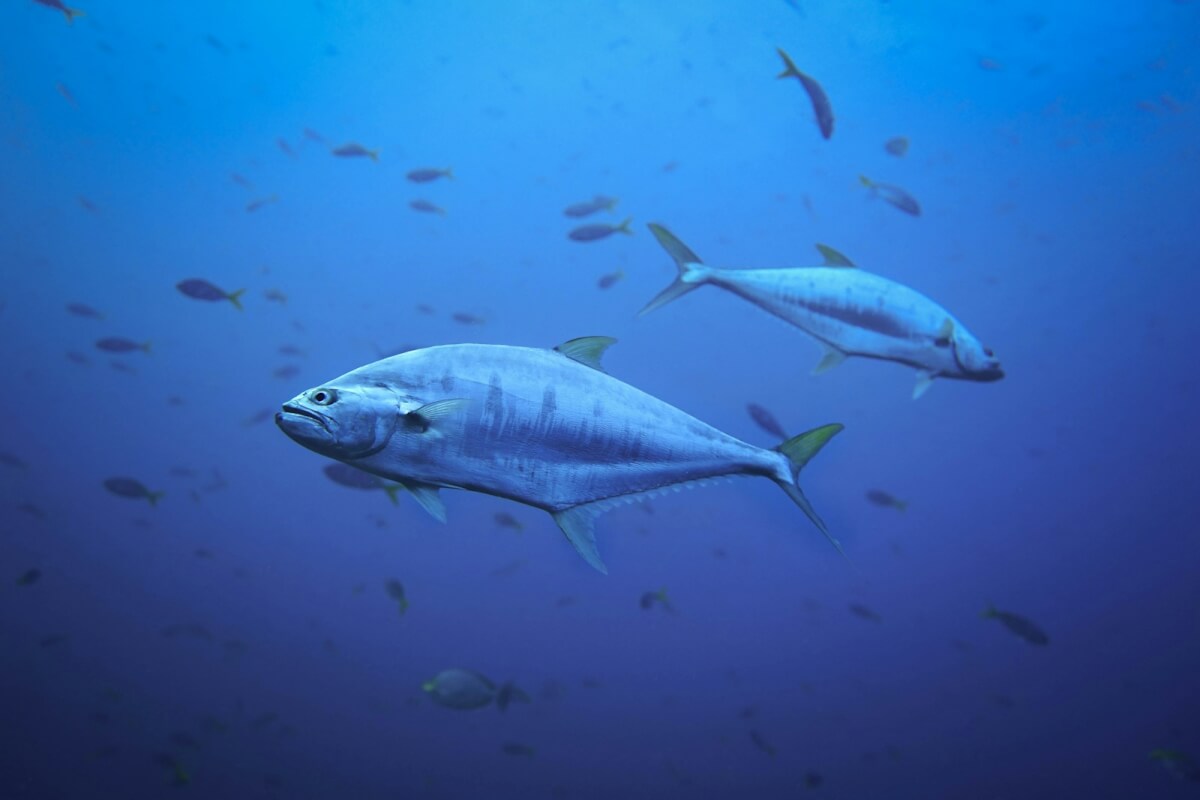🗝️ Key Takeaways
- Despite decreasing mercury emissions since the 1970s, methylmercury contamination levels in tropical tuna species have remained largely unchanged over the past 50 years.
- Mathematical models suggest tuna mercury levels may be saturated by a historical “legacy” of mercury pollution accumulated in the deeper ocean from centuries of industrial activities.
- More aggressive policies targeting mercury emissions coupled with long-term monitoring of seafood contamination will likely be needed to meaningfully lower mercury levels in tuna and other widely consumed fish.
PARIS — Tuna is a dietary staple for millions across the globe. Skipjack, yellowfin, and bigeye tuna account for 94% of the world’s commercial tuna catch. However, concerns over mercury exposure from eating tuna have persisted for decades. Now, new research suggests that while policies have successfully reduced mercury emissions since the 1970s, tuna contamination levels worldwide have largely remained static.
Methylmercury is a potent neurotoxin that can cause severe health effects in humans. Unborn children and infants are particularly vulnerable. The new findings by scientists at The National Centre for Scientific Research in France have troubling implications, suggesting modern tuna reflect decades or even centuries of global pollution that has saturated ocean waters. To lower contamination levels, researchers argue more aggressive emission targets and monitoring of seafood is urgently needed.

Tracing Tuna Mercury Back 50 Years
For their study, the international team compiled and standardized tuna mercury data from the Pacific, Atlantic and Indian Oceans dating back to 1971. In total, muscle tissue samples from close to 3,000 tuna were analyzed over the five-decade span. By honing in on tropical tuna species with more restricted ranges, the goal was to approximate contamination levels in the surrounding waters that the fish inhabit. Because they don’t undergo transoceanic migrations, any contamination found in the animals’ muscles likely reflects the waters they swim in.
Accounting for certain bioaccumulation effects, the researchers uncovered a surprising global trend – or rather – lack thereof. Despite policies driving down atmospheric mercury emissions since the 1970s, contamination levels in tropical tunas have largely flatlined for 50 years.
Industrial Legacy Pollution Link
So why have decades of environmental protections seemingly failed to budge tuna mercury levels? The researchers posit industrial mercury pollution from earlier eras has created a historical “legacy” in the oceans.
Most tuna are surface dwellers. But the team theorizes ancient mercury emissions may have sunk and mixed into deeper ocean waters over time. Recent analyses show around two-thirds of the total mercury in the top thousand meters of the sea was deposited before industrialization.
Upwelling currents and other ocean mixing processes could now be bringing some of this subsurface reservoir of legacy mercury back up into shallower waters. In effect, despite recent emission reductions, ocean tuna may still be tapping into a tainted mercury supply accumulated over centuries of pollution.

Models Suggest Long-Time Lags to Impact Tuna
The researchers built mathematical simulations to explore various policy scenarios and their predicted impact on future ocean and tuna mercury levels. The models indicate even dramatic reductions in modern emissions may take over a decade to influence shallow ocean contamination. Another 10 to 25 years would likely pass before reduced levels finally manifest in tuna populations.
“Modeling suggests that this limited response observed in tunas likely reflects the inertia of surface ocean mercury with respect to declining emissions,” the authors write.
In one troubling observation from the northwestern Pacific, tuna mercury levels were actually seen rising in the late 1990s. The team believes this spike reflects concurrent increases in Asian mercury emissions at the time. This finding underscores a relatively fast response when emission levels are climbing rather than falling.
Overall though, the centuries-long memory of ocean waters means legacy mercury pollution will likely continue impacting global tuna – and seafood-loving consumers – for decades to come.

Call for More Aggressive Policy and Monitoring
The researchers stress their models do not account for all complex variables. More research is needed to better understand ocean mercury sequestration, transportation, bioaccumulation and toxicity. However, they believe their findings clearly demonstrate a pressing need for more aggressive mercury policies looking ahead.
“To achieve measurable declines in mercury concentrations in highly consumed pelagic fish in the near future, aggressive emission reductions and long-term and continuous mercury monitoring in marine biota are needed,” the authors urge.
With tuna consumption rising across the developing world, ongoing surveillance of seafood contamination will also be vital to help balance health risks for the world’s most vulnerable groups.
So while the new study may dash hopes of lowering tuna mercury levels overnight, it provides an important wake-up call for policymakers and scientists. Tackling tuna’s legacy mercury burden will demand commitments and coordinated efforts spanning generations – but the future health of oceans and seafood lovers may just depend on it.
The study is published in Environmental Science & Technology Letters.
You Might Also Be Interested In:
- Is sushi safe? Scientists reveal chances of bacterial infections from eating raw fish
- Something’s fishy: Many college students eating too much tuna, unaware of mercury risks
- Frogs across the U.S. may be dying of mercury poisoning
- Surprising link discovered between spiders and mercury spreading through food chain
